Tilapia production booming
Fives years ago, I tried to make an estimate on the potential growth of tilapia production by the year 2010, and then 2.5 million tonnes seemed to be appropriate. This level was already reached in 2005!
This graph shows very clearly that aquaculture was the main responsible for the increase, while capture fisheries of tilapia stayed more or less stable over the years.
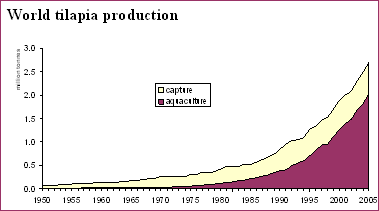 |
China is by far the main tilapia producing country, with almost 1 million tonnes production in 2005. Also Egypt reported an impressive increase in production during the early nineties, when production suddenly passed from 25 000 tonnes in 1990 to 115 000 tonnes in 1991. For ten years, Egyptian tilapia production expanded steadily to reach 300 000 tonnes in 2001. However, since that date, Egyptian production has stayed quite stable. On the other hand, production in Indonesia and the Philippines increased significantly during the past decade to 200 000 tonnes each.
Asia is the main region where tilapia is now produced and is also the main responsible for the spectacular growth experienced during the past decade. Asia accounts today for 63% of total tilapia production, while in 1990 this percentage was 50%. However, also Africa and South America have experienced a substantial increase in their tilapia output during the past decade.
Total tilapia production is mainly Nile tilapia (Oreochromis niloticus). All new countries entering tilapia production concentrate on this species, which is easy to grow. Total tilapia production in 2010 can be forecast to be 3.5 million tonnes, with the bulk coming from aquaculture, the majority of the increase will come from Nile tilapia and be produced in China.
In recent years, Uganda has overtaken Egypt is the main tilapia capturing nation with over 150 000 tonnes. Wild tilapia catches have gone up, as a result of increasing catches by Uganda. All other countries reported lower production, especially Egypt.
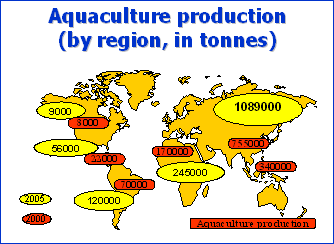
Far more interesting than the capture production is the aquaculture output. China is by far the main tilapia culturing country with production close to 1 million tonnes. Egypt has been expanding its culturing industry in recent years and is now producing 200 000 tonnes. Taiwan Province of China produces about 80 000 tonnes of cultured tilapia per year. Indonesia, Philippines and Thailand have grown in the past years under observation, all overtaking Taiwan PC. it is interesting to note that many countries are culturing at least some tilapia. Mexico, which is among the main tilapia capturing countries, does not any significant role in aquaculture. This country has a huge potential to become one of the main tilapia producing countries.
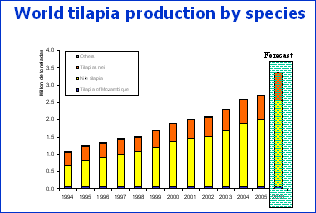
Asia represents about 70% of total tilapia production. Tilapia production increased strongly in just 5 years, and in all regions, no region excluded. In Eastern Asia the production increase from 755 000 tonnes to 1.1 million tonnes, while in South America production boomed from 70 000 tonnes to 120 000 tonnes, mainly due to higher production in Ecuador. In Central America, production more than double in just five years, while Africa and SE Asia were about stable.
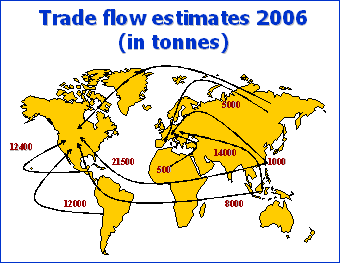
These trade flow estimates show that China is the main supplier of tilapia to the international market with 104 000 tonnes going to the USA and about 5000 tonnes to the EU market. Taiwan (Province of China) send 21 500 tonnes to the USA and roughly 1 000 tonnes to the EU. Other Asian countries contribute with 8 000 tonnes going to the US market and 14 000 tonnes to the EU market. Finally Central America exports about 12 400 tonnes, all to the US market, and almost all in fresh fillet form, while 12 000 tonnes of this product are shipped from South America mainly Ecuador to the same market. Almost no tilapia goes from Latin America to Europe. Africa has an extremely low export of tilapia, with an estimated 500 tonnes going to Europe. Israel is an important market, but it was impossible to quantify it.
Overall international trade is relatively unimportant compared to production and domestic usage. However, export of tilapia is expanding with China (mainland and Taiwan), Thailand, Indonesia, Singapore, Costa Rica and Ecuador as the main exporting countries. Overall the world tilapia trade can be estimated at 190 000 tonnes (product weight) with the USA taking about more than 80% of this.
USA main tilapia market and consumption increasing strongly
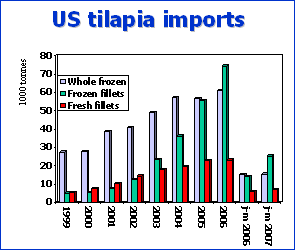
US tilapia consumption can be estimated at 360 000 tonnes liveweight equivalent, the fifth major seafood consumed in the USA. As a result of the strong demand, imports of tilapia into the USA again hit a new record in the first three months of 2007. Some 47 300 tonnes of tilapia were imported, 35% more than during the corresponding 2006 period. The trend already observed during the past two years continued, with frozen fillet imports growing strongly, while whole frozen was stable. On the positive side for Latin American producers was the 20% increase in fresh fillet exports during the January-March 2007 period.
Ecuador continues to be the main exporter of fresh tilapia fillets to the US market, accounting for 48% of total supply. The country is expanding its position due to the above mentioned new tilapia farms that started production in late 2006. Honduras, that had announced it would overtake soon Ecuador, is limping behind. Costa Rica seems to have recovered from the survival of fingerlings problems, experienced in late 2005. The country shipped 1 000 tonnes in the first three months of 2007, 40% more than in the same period of 2006. Brazilian exports of fresh tilapia fillets declined sharply, as all tilapia companies in the country prefer the domestic market, due to the strong Brazilian currency, which makes exports less attractive.
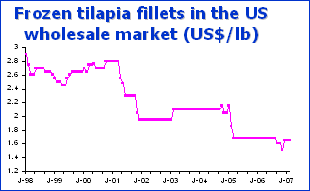
However, fresh tilapia fillets are rather a niche market now, with very high prices. The real market setter is frozen tilapia fillets, mainly from China. The growth of Chinese products on the US market is incredible. In the first three months of 2007, exports of frozen tilapia fillets from China to the US market almost double to 22 000 tonnes. The country is thus dominating this market with a 92% share. All other players are marginal.

Overall, despite the overall good demand, the massive imports were accompanied by sharply declining prices of both fresh and frozen tilapia fillets. The overall trend is for further decline of prices. How much more frozen tilapia fillets will enter the USA in the coming months? It has to be seen whether the antibiotics discussion of catfish from China will have an impact on the demand for Chinese tilapia as well. If the market continues to grow as at present, total tilapia imports into the USA can easily reach 180 000 tonnes in the course of 2007. This compares to 160 000 tonnes of total groundfish imports into the US market. This figure shows the outstanding importance of tilapia in the US seafood industry.
Outlook very good
There is no doubt that tilapia supply will continue to expand in coming years. Strong increases are coming from Latin America, but mainly directed to US market. On the other hand, Indonesia and Thailand have discovered and opened the EU market for their tilapia products. China is expected to further increase its presence on world market, especially in Europe. More value added tilapia production is likely in developing countries, including fish fingers. We will see more foreign investment in tilapia farms in developing countries, targeting mainly foreign markets. Prices are likely to recover from present low level, in view of overall increasing food prices and due to higher feed and transport costs.


